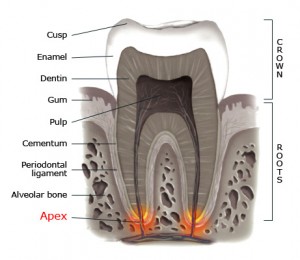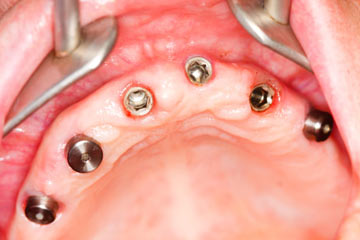Blog
What is an Apex of a Tooth?
 At its base definition, apex means the highest part of something. In the dental world, it’s referring to the very end of a root, where it connects to the pulp and is able to get blood and nutrients from the body. As a general rule, if you are hearing “tooth apex” from a dentist, chances are a root canal will be involved. If you hear the term “Open Apex” it is generally referring to a gap between the apex of a tooth and the jaw. It can heal itself but is often lightly assisted to make sure that the tooth does not die (become necrotic).
At its base definition, apex means the highest part of something. In the dental world, it’s referring to the very end of a root, where it connects to the pulp and is able to get blood and nutrients from the body. As a general rule, if you are hearing “tooth apex” from a dentist, chances are a root canal will be involved. If you hear the term “Open Apex” it is generally referring to a gap between the apex of a tooth and the jaw. It can heal itself but is often lightly assisted to make sure that the tooth does not die (become necrotic).
To understand more fully, a tooth is made up of about 7 different sections, being further broken down into the crown (what can be seen above the gums), and the root (what is visually hidden). The apex is the very bottom part of the root that has a nerve ending that attaches to the nerves in the jaw.’’
A dental abscess occurs at the apex of the tooth. A sack (dental cyst) appears that can put pressure on the nerves, and sometimes block the nerve. This is known as a blocked canal, which can cause your tooth to die from getting a lack of nutrients. Abscesses are often caused by bigger issues, such as an infected pulp. Infected pulps can be very damaging to the body and can sometimes even kill you if the infection spreads to other, more vital parts of the body. In this case, they will put you on antibiotics to treat the infection, and surgically remove the inflamed section of the tooth.
When the tooth cannot be saved because of apex damage, typically from a cyst, your dentist may perform a root canal. When you have a root canal, the dentist goes into the tooth and removes the nerve and infected pulp in order to save the tooth (even though it is no longer “alive”). This is typically needed to prevent an infection from spreading.
Save-A-Tooth, Saving Avulsed Teeth
 Dental Avulsion occurs when a tooth is knocked out of its socket, with the ligament being stretched to the point of tearing. This normally occurs because of trauma, and can often times be reattached without much of an issue if the tooth is kept safely and a dentist is visited as soon as possible (within a few hours). Making sure the tooth is in an environment as similar to the mouth as possible, with the least amount of pressure on it, is key for making sure it can be reattached without significant problem.
Dental Avulsion occurs when a tooth is knocked out of its socket, with the ligament being stretched to the point of tearing. This normally occurs because of trauma, and can often times be reattached without much of an issue if the tooth is kept safely and a dentist is visited as soon as possible (within a few hours). Making sure the tooth is in an environment as similar to the mouth as possible, with the least amount of pressure on it, is key for making sure it can be reattached without significant problem.
However, if kept dry the PDL cells will begin to die after fifteen minutes and, without a biologically rejuvenating medium, will all be dead within sixty minutes. Often a dentist is not available within sixty minutes and so the knocked-out teeth must be placed in a trauma free and biologically restorative environment. The only medical device that can safely protect and rejuvenate teeth for twenty four hours is the Save-A-Tooth system.
Save-A-Tooth offers a method for you to store an avulsed tooth in a solution by offering a system that can help the patient store it safely, which will help relieve them of stress from the incident. For more serious issues that require a dentist, it keeps the tooth in a place that will keep the ligament safe until you can see your dentist. With Save-A-Tooth, it allows for a 90% chance that the knocked-out tooth will be able to be safely reinserted. Some dentists recommend using milk, but there have actually been no human studies proving that milk actually helps. The human socket it came from is the best environment for the tooth, but it runs the risk of crushing the cells involved with the ligament therefore making the reattachment rate drop dramatically.
Even laboratory and animal studies show that storage of teeth in milk only maintains the vitality of PDL cells at 20-40%. This is because milk has no available rejuvenating metabolites like Ca+ or glucose. When it was first recommended thirty years ago, it was a good storage medium but now it is an old, inferior technology. The old rationale for milk was that it was available everywhere. This is untrue. For example, it is not available in automobile accidents, sports playing fields or in hospital emergency rooms.
One thing you must remember is to never touch the root of the tooth. This causes similar damage. Keeping the tooth in a sterile solution container until it reaches the dentist is your best bet. Dentists, mothers, athletic trainers and healthcare personal should change their thinking to a preventive one rather than a reactive one. They should consider the treatment of knocked out teeth the same way that people think of severe allergic reactions to bee stings or food. An EpiPen needs to be purchased ahead of time since when it is needed it must be available immediately. If people have to look for one when the allergic reaction begins, the person might die. Similarly, if a tooth is knocked out, a SAT kit must be available immediately, or the tooth will die and be rejected by the body after it is re-implanted.
SAT kits should be purchased and readily available by schools, dentists, emergency rooms, ambulances, sports teams and, generally, anywhere people are active. Since the SAT kit lasts two years, is the saving of a front tooth worth $12.50 a year?
Dental Education Puppets
If you have gone to the dentist, you may have seen one of these puppets before in a dental office. They are pretty popular in dental offices that are popular with children. They tend to be used as educational tools to help children understand things about their teeth. They also have an added benefit of being incredibly weird looking, especially since the dental education puppet also has a way of looking like a cute plush toy. I recently saw a small collection of these out at a Lake Oswego Dentist’s Office, and they are very weird to see and interact with. though it is a little fun to snap at people.
There are many different kinds, including dragon, horse, shark, tiger, monkey, and dog. There is even a unicorn. They are good for dental health education
The real goal is so you can brush them and show kids proper brushing techniques. They are a handy teaching aid that helps kids understand the basic, but still important parts of brushing our teeth. There are actually many useful toys and books for teaching kids how to brush their teeth, even some for adults, like dental models. Its nice to know there are plenty of products out there to help you stay informed on proper dental hygiene, many of which can be found relatively easily.
Clean Water Portland Campaign Kick Off, and My Thoughts on the Fluoride
 I went to the “Clean Water Portland” campaign kick off last night, to mostly shake hands and see what people were talking about.
I went to the “Clean Water Portland” campaign kick off last night, to mostly shake hands and see what people were talking about.
I am attempting to stay bilateral on the issue and not take any sides. One of my biggest complaints on the issue is that studies on both sides are very murky and inconclusive. On the other hand, the government handles fluoride in a very underhanded, murky, and sometimes arguably criminal manner. If I had any objection to fluoride, its the way they are handling it, and not the fluoride itself.
Portland’s Case For Fluoride
Strengths of The Case for Fluoride
The entirety of their want to insert fluoride into the water supply is to help people with the highest poverty levels maintain healthy teeth. There is evidence to support that besides young children get large health benefits.
Portland Poverty Levels.
Portland: 20.3%
Whole state: 19.0%
The national average of below poverty levels is 12.2%. We are 8% above the national average for poverty. This creates a good case for the need of fluoride in the drinking water.
Weaknesses of The Case for Fluoride
Young children can be hurt by fluoride
Children under 6 months old are very weak to fluoride, and its not under dispute. This may even effect children in the womb. This of course is hardest to avoid if you are under the poverty level, as it is harder to find alternative water and resources for your child.
Children under 2 still maintain a weakness to fluoride and having long term damage from it. What’s weird, is this is often just entirely disregarded and ignored in the public forum.
History of Over Fluoridating Water
The problem with introducing fluoride to the water, is sometimes they introduce too much. The recommended amount would be 1mg/l. They have found levels to be as high as 11.5mg/l, ten times higher then the recommended amount. That is an extreme, but the fluoride levels tend to actually reach as high as 4mg/l, which is still 4 times the recommended amount. The problem here Isn’t the fluoride, but the sloppy way it is routinely handled. That seems to be repeatedly, the problem with fluoride.
Introducing Fluoride with out allowing us to vote
We are a representative democracy, but with how torn people often are on this issue it should be put to a vote, not just introduce it. The Portland City Council voted 5-0 to add fluoride, and objecting activists got 20,000 signatures in 30 days to object to the action.
Where is this fluoride coming from
I have heard people say everything from its coming from Uranium Mines, to the aluminum industry, to a byproduct of fertilizer. Can someone just please tell us where it is actually coming from so I can stop hearing people tell me its a byproduct of time traveling Nazi Scientists already?
The FDA and EPA handle the issue badly
For some reason the EPA doesn’t deal with it. Except when it does in some things like mouthwash. The EPA handles it, and approves it with out much justification. The EPA Union however objects to it. Like, what is going on here? The government needs to handle this responsibly and in a way that makes sense- just like everything else. Honestly, I have yet to see a study the EPA would even accept.
Portland’s Case Against Fluoride
Strength of the Case Against Fluoride
People who gain a cursory level of knowledge about fluoride tend to be against it
Surface levels of information really do make it seem like fluoride is bad. The majority of studies show some negative effects in one way or another, and the undeniable proof that it hurts children under two year of age. It would appear there are more minor negatives then there are minor positives. When put side by side, its easy to discount the benefits of teeth with the very small piles of evidence for very serious problems.
The government needs to explain why we need it, not us justifying why we don’t
The studies on both sides are incredibly murky with so many different variables and correlation issues it makes it really hard to read. While there is possibly lower IQs caused by fluoride, these studies also show oddly high levels of malnutrition and other serious issues. They are all done retrospectively in different areas, with an odd selection of individuals to check. With that, it comes down to, in at the very least my opinion, the government need to provide better evidence.
Weaknesses of the Case Against Fluoride
Bogged down by fanatics and conspiracy theorists
At the meeting, the first 3 people I met were sane normal people. The next two were not. I want to avoid specifics to as to not offend anyone, but this older woman approached the need to remove fluoride from water like it was Armageddon. The truth is, fluoride is a less important issue then the war. To act like we need to tell everyone and stop the injustice of fluoride comes off a little crazy. A person I ran into while leaving the event and talking, immediately went to how the nazi’s tested and how big beer is blocking Portland local beer.
When you have a good reason to object to something, its contagious. People can’t help but to be compelled by your argument. When you have bad arguments, it compels people away from your stand point. This vocal minority effects people in ways that’s hard to explain or understand.
Murky wording and studies
Factual support that fluoridation chemicals are industrial byproducts. This statement doesn’t tell me why its bad. Leather, dog food, and manure is a byproduct of the beef industry, for example. Nothing really wrong with that. I need to know why it being a waste byproduct is bad.
Contains Arsenic and other toxins. So does bottled water- often times more then water that has fluoride added to it.
They all come off something like this:
I have 12 studies proving a correlation with lower IQs in children. Here is 3 of them. Why am I given only 3? Give me all twelve. I went and I found all twelve, and I start to understand why. Its because there are three that are convincing. One of the studies actually only focused on children who already had high levels of fluorosis. Numerous studies were done is China, and often found more shocking discovers of high levels of arsenic in their water. One of them only focused on fluorosis that was caused by the burning of coal. The language here is all wrong. One wasn’t even translated to english.
It should be worded “chronic fluorosis cause lower IQ”. And they should be saying 3 studies. Here is the strongest, in my opinion.
It goes back to the same issue, good arguments don’t need trickery. They are compelling on their own.
Why Save a Natural Tooth Over Getting a Dental Implant?
 If a tooth is already having problems, why would you consider patching it up, or bonding it? It would seem like its already decaying, and once the initial dentin has eroded there is no earning it back. Especially since a dying nerve can be incredibly painful… why shouldn’t we just want to remove the whole tooth? What is the benefits of a natural tooth over an artificial one?
If a tooth is already having problems, why would you consider patching it up, or bonding it? It would seem like its already decaying, and once the initial dentin has eroded there is no earning it back. Especially since a dying nerve can be incredibly painful… why shouldn’t we just want to remove the whole tooth? What is the benefits of a natural tooth over an artificial one?
One of the main differences between a natural tooth and an artificial tooth is that a tooth has periodontal ligaments. Periodontal ligament (aka periodontal fibers) is a type of connective tissue fiber that attach the tooth directly to the aveolar bone. Dental Implants are drilled right into the bone. These periodontal ligaments help absorb pressure for a tooth, making it less stressful on your mouth when you tap, chew, or even touch a tooth. The stress on the periodontal ligaments also helps you to know when something could be wrong with the tooth, such as it getting loose of being twisted out of shape. You could see this as directly helpful for maintaining dental health.
When a tooth is removed, part of the aveolar bone is also lost. Also, when a tooth is removed, there is an aesthetic change- your gum line begins to recede.
These are probably the most meaningful reasons not to just jump into removing a tooth directly- even if it seems like a money and time saver. The lack of periodontal ligaments have a lot of long term problems for your jaw. So dentists typically try to limit the amount of teeth that they have to remove and place implants to keep your mouth healthier, longer. While implants have an important role in dentistry, most dentists will always try to save a tooth when possible.
